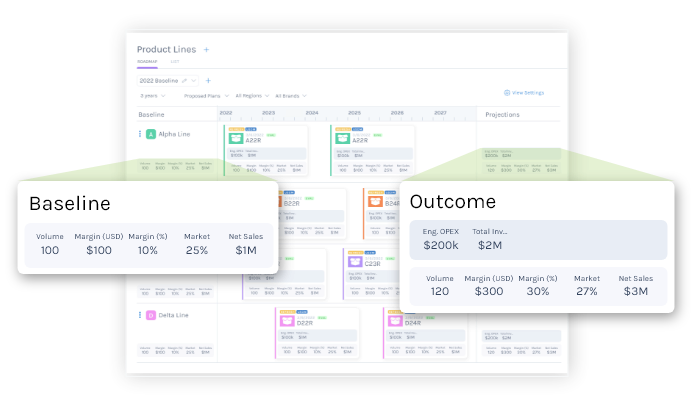The 7 Key Challenges to Product Roadmap Management
 By
Maziar Adl
·
4 minute read
By
Maziar Adl
·
4 minute read
 Every year, innovation brings new and improved products to life, making many amazing and brilliant things available to us, from advanced electronic systems to fuel-efficient or electric vehicles to AI technology, making the dangerous industries safer for humans.
Every year, innovation brings new and improved products to life, making many amazing and brilliant things available to us, from advanced electronic systems to fuel-efficient or electric vehicles to AI technology, making the dangerous industries safer for humans.
And behind every product vision that is launched, there is an expertly managed product roadmap. It takes skill and careful planning to build a product roadmap, but it requires even more strategy to manage the roadmap to success. Let's look at seven key challenges of product roadmap management and how to address them.
1. Clarity
In any scenario, knowing the end goal is vital.
Just as you would set yourself a personal goal and create a plan to achieve it, creating a product roadmap requires clearly defined product visions. Depending on your business, this may be as simple as creating a new model for a popular product, but it might also mean launching something completely new. You may be responding to customer feedback or solving particular customer problems with something new. In any scenario, knowing the end goal is vital.
It's impossible to manage a roadmap without clearly defining that end goal. Once you have those established, creating the roadmap should come naturally. The planning part will likely involve input from stakeholders in the process, but once your core features are confirmed, and your product is defined, then you can put your roadmap into action. Clarity makes everything easier.
2. Establishing Milestones and Tracking Timelines
Once you have a clear destination, every roadmap needs to have a timeline. This process begins with establishing important milestones. Which components must be produced before the next stage can start, and which phases of the product development depend on others? You’ll also want to ask questions, such as when should you introduce a product to new markets and in what sequence should they be released? Launching similar products too close together can cause confusion or lead to the cannibalization of other products in your portfolio.

Once you know the flow of the production, you can establish the timelines it will take to develop the product and identify opportunities to speed up the process or increase efficiency. When everyone involved in the product knows the projected timeline, the easier it is to manage and communicate that timeline.
3. Accurate Metrics
With clarity and a timeline established, you're well on your way to having a high-level vision and strategy for your product. The next challenge is to create a strategic product roadmap that leads you to that vision. The only way to know if your product plan is on target is to have accurate metrics that show whether you're on the path to reaching a milestone or not.

When you set out to write down your goals, it's important to establish which metrics will indicate progress and need to be tracked. The next crucial step is to establish when and where to record these metrics so that everyone on the team can see them. Knowing the numbers helps to inform important decisions at every step of the plan.
4. Effective Communication
These different modes of communication can become exhausting when you don't have a plan in place.
In business, the ability to communicate and collaborate effectively and consistently is vital to success. The biggest communication challenge for companies that create and produce products is connecting with teams that vary in size and location. In some cases, you might be able to meet in person, but more often than not, you need a remote communication strategy. You may have teams reporting and checking in through video calls, phone calls, emails, and team management apps. These different modes of communication can become exhausting when you don't have a plan in place.
5. Meaningful Collaboration

Hand-in-hand with communication comes collaboration. Your teams cannot work in isolation but must work together to ensure the product plan is on schedule and flowing seamlessly. As the product manager, your role is to bring together cross-functional teams with different skills and interests to work together on the product. The key is to communicate information everyone needs to know, rather than relying heavily on engineering jargon or financial terminology. A high-level product view allows you to choose the data to present and illustrate to everyone on board the important ideas or concerns. When the whole room understands, they can collaborate more effectively to solve a problem or align their efforts. Having a central place for everyone to communicate, leave notes, and report data also drastically reduces miscommunication and helps your product teams stay on track.
6. Supply Chain Problems
The biggest challenge of managing a product roadmap is often outside your control, which comes from supply chain disruptions.
So far, most of these challenges we have covered are hurdles that can be avoided or mediated with strategy. The biggest challenge of managing a product roadmap is often outside your control, which comes from supply chain disruptions. If a certain component is delayed due to the necessary material or part being unavailable or there are shortages in the market, it can throw a wrench into the plan.
Savvy product managers always think about contingency plans and know their product strategies inside and out. Managers should know if alternative solutions are available or have a team that can inform them on what options are available that still meet the goals of the product. This could involve sharing or reusing components from another product line with a similar value proposition while the shortage or delay lasts.
7. Experienced Product Manager
All these challenges can be overcome by having the right people in the right place, especially the product manager. An effective product manager will:
- Maintain excellent communication
- Facilitate collaboration,
- Have a solid understanding of the product's progress along the timeline.
How to Create a Product Roadmap Strategy

We went through the list of the top seven challenges to product roadmap management. Now, let's review the essential steps to create an effective product roadmap strategy.
- Establish clarity by defining the end product and the product goals.
- Define the milestones needed to achieve the end product and create a timeline that enables the scheduled product release.
- Plan which metrics need to be tracked and create a procedure to report accurately and regularly where everyone involved can access them.
- Create accessible communication channels to keep everyone on target and working together.
- Facilitate collaboration between departments and teams regardless of their locations.
- Have alternative plans to mitigate the effects of supply chain problems.
- Support the product manager to have the tools and support necessary to manage the roadmap.
The easiest way to check all the boxes to manage a product roadmap strategy is to use product roadmap management software. Not only will software help production run smoothly, but it will empower your product managers to excel while also reducing their workload with automation and streamlined integrations.
Product Roadmap Management (PRM) Software for Manufacturers
Gocious is capable product roadmap software designed with manufacturing in mind. Measuring and tracking all your key metrics in one location makes collaboration and communication much easier. A tool such as Gocious enables different access levels for each stakeholder. It provides a product line dashboard that easily allows users with abilities to view-only, edit, and add data for the rest of the team. Shared documents that send alerts to new changes or revisions keep everyone up-to-date. Get in touch with us today to set up your free demo of Gocious to see how our software can boost your business.
